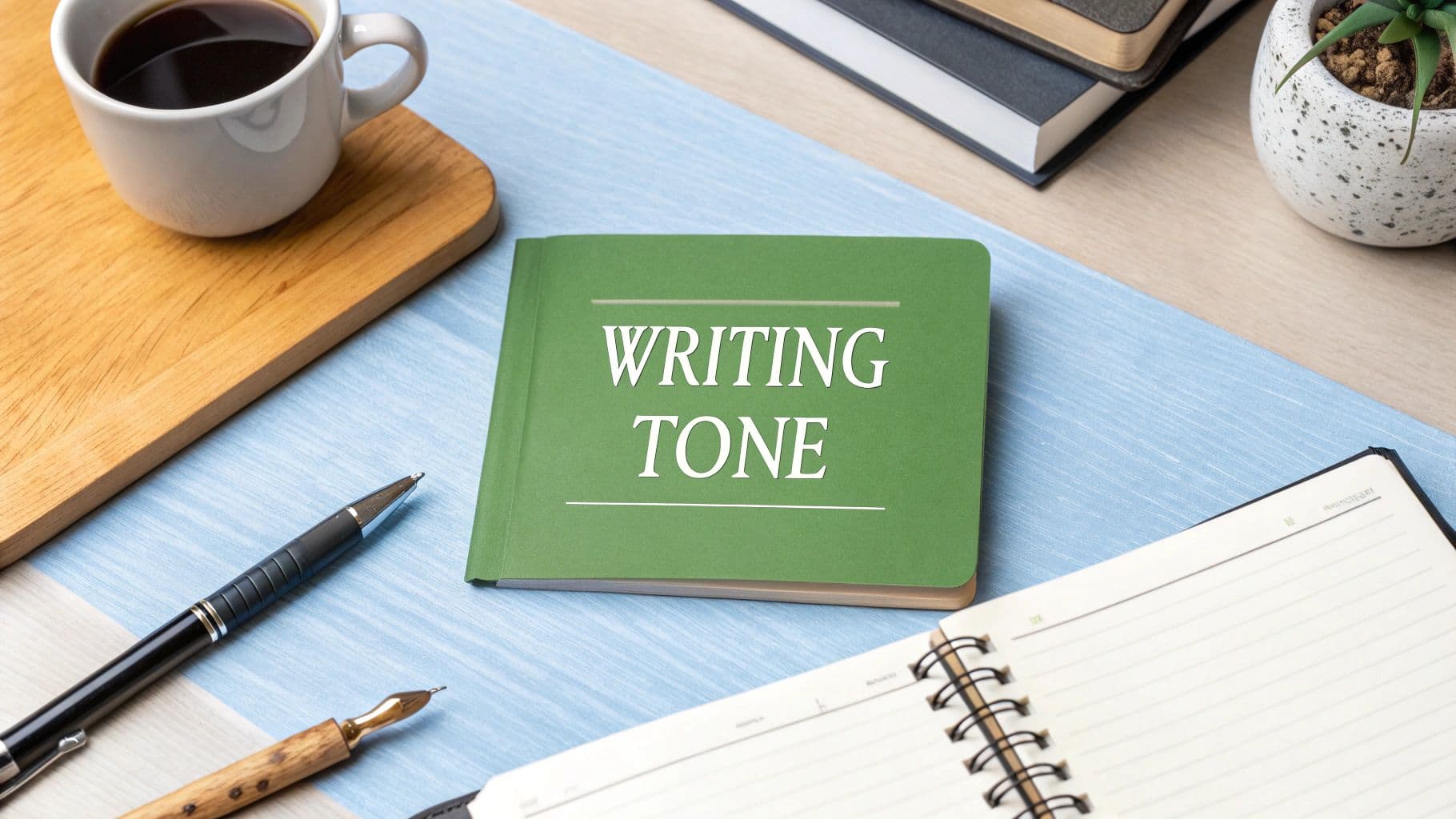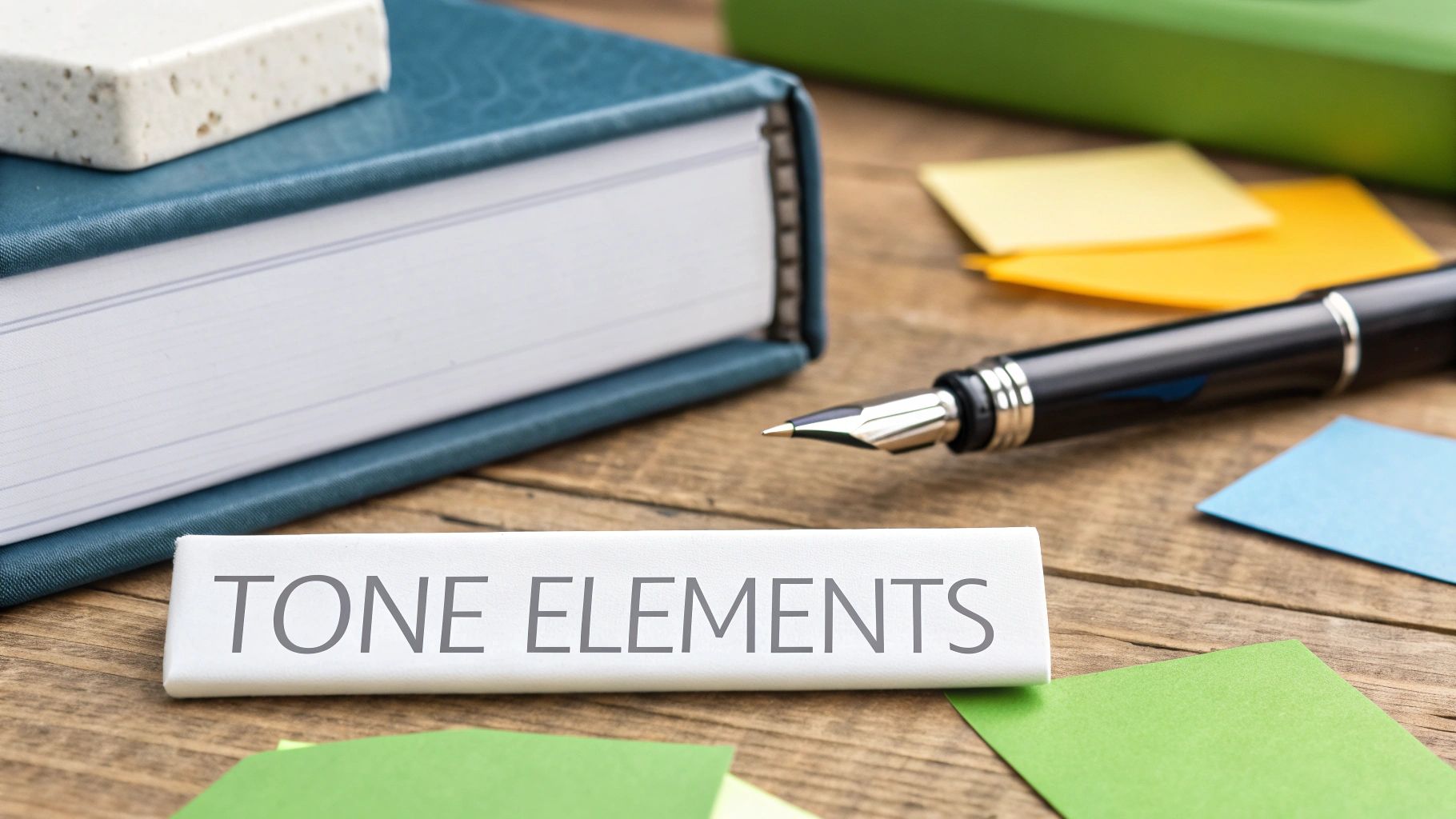
What Is Tone in Writing? A Guide to Mastering It
August 12, 2025
Let's be honest—what you say matters, but how you say it can make all the difference. In writing, that "how" is your tone. It’s the attitude or emotion that comes through in your words, giving your writing a distinct personality. Is it friendly? Serious? Playful? That's your tone at work.
What Is Writing Tone and Why Does It Matter?
Think about a real-life conversation. You can tell if someone is joking or being serious not just by their words, but by their tone of voice, their smile, or their body language. Writing doesn't have those visual and auditory cues, so it has to rely on other tools—like word choice, punctuation, and sentence structure—to get that same feeling across.
Without a clear tone, your message can easily get lost in translation. A helpful email can sound condescending. A passionate argument can come off as aggressive. Your reader is relying entirely on your words to understand the emotion behind them.
Tone is the emotional lens through which your reader experiences the story. It’s what transforms a simple message into a persuasive force that builds connections and drives action.
The Impact of Mastering Tone
Nailing the right tone isn't just a nice-to-have; it's one of the core elements of good writing that separates forgettable content from something that truly connects. When you get the tone right, you can:
- Build Trust: A consistent and authentic tone makes you feel more credible. When your writing feels genuine, readers are far more likely to trust what you have to say.
- Engage Your Audience: The right tone grabs and holds attention. A conversational, energetic tone in a blog post, for example, makes the information feel less like a lecture and more like a great chat.
- Persuade and Influence: Tone is a powerful tool for persuasion. An authoritative tone can signal expertise and build confidence, while an empathetic one can create an emotional connection that moves people to act.
Ultimately, understanding what writing tone is—and how to control it—gives you the power to guide your reader’s experience. It ensures your message doesn't just get delivered but gets felt the way you intended.
How the Right Tone Builds Trust and Engagement

Your writing tone is so much more than just a bit of decorative flair. It's a powerful tool for forging genuine relationships with your readers. When you get it right, a consistent and appropriate tone turns a simple message into something persuasive—something that builds brand loyalty and authority.
Think about the difference between a cold, robotic chatbot response and a warm, helpful email. One feels distant and impersonal, while the other makes you feel seen and understood. That’s the power of tone in action. When your words resonate on an emotional level, you lay a foundation of trust that keeps people coming back.
The Connection Between Tone and Trustworthiness
A friendly, confident, and empathetic tone sends a clear signal: you see your reader as a person, not just another number on a dashboard. This human touch is absolutely essential for building credibility, especially online where you don't have the benefit of face-to-face interaction. The right tone shows you respect your reader's time and intelligence.
The data backs this up, too. One study found that over 70% of users associate a friendly tone in writing with higher trustworthiness. It’s a stark reminder of how critical tone is for establishing rapport and making your message stick.
The right tone doesn't just inform; it connects. By making readers feel seen and respected, you create an environment where they are more open to your ideas and message.
This connection becomes even more important when you're tackling complex topics. For instance, when explaining new technology, a clear and reassuring tone is vital for building AI trust through understanding. You want your content to feel less like a lecture and more like a helpful conversation. For more on that, check out our guide on how to write conversationally.
Finding Your Voice in the Spectrum of Tones
Knowing what is tone in writing is one thing, but actually choosing the right one for your audience? That’s where the real skill comes in. The options aren't just a random list of adjectives. Think of them as a whole spectrum of attitudes you can use to really connect with your reader.
Instead of getting lost in a sea of words, it helps to group them into practical categories. This infographic shows a few common tones organized by what they help you achieve.

As you can see, every tone has a job to do—whether that’s building professional trust, creating a friendly vibe, or sparking a specific emotion.
Exploring the Categories of Tone
Thinking about tone in these broader categories makes the whole process less about guessing and more about strategy. Let's break down a few common groupings to see how they work in the real world.
Professional Tones: This is your formal, authoritative, or objective voice. The goal here is clarity, credibility, and expertise. It's the go-to for academic papers, technical manuals, and official company announcements.
Relational Tones: Here, you'll find friendly, conversational, and encouraging language. The main purpose is to build a relationship and make the reader feel like they're part of a conversation. It’s perfect for blog posts, email newsletters, and social media updates.
Emotional Tones: Empathetic, optimistic, and humorous tones live in this category. They’re all about creating a strong emotional response to build deeper connections or inspire someone to take action. You’ll see this a lot in powerful storytelling and persuasive marketing.
The key isn’t just picking a tone, but understanding why you’re picking it. A formal tone builds authority. A conversational one builds a relationship. Each choice completely changes how the reader experiences your words.
To get a better feel for the huge expressive range you have to play with, it’s worth exploring more examples of different tones of writing. Seeing how different word choices and sentence structures create a specific mood will give you a much clearer picture. Mastering this is what separates good writing from truly great writing.
How to Spot Tone in the Wild
So, how do you get good at this? You have to learn how to spot tone in the wild. Think of it like becoming a detective for words. When you read something, you're not just absorbing information; you're looking for the clues that give the writing its specific attitude and feel.
This isn't about wild guesses. It’s about paying close attention to the raw materials of writing. Once you can break a text down into its core components, you can see exactly how the author built a certain feeling. It’s a skill that helps you understand others, but more importantly, it makes you incredibly aware of what’s happening in your own drafts.
Your Tone-Spotting Toolkit
To get a read on the tone of a piece, you really only need to look for three main clues. Each one tells you something different about the author's attitude toward the subject and, of course, the reader.
Diction (Word Choice): This is the most obvious clue. Look at the actual words on the page. Are they formal and buttoned-up, like "consequently" or "utilize"? Or are they more casual, like "so" or "use"? Do they carry a positive charge ("brilliant," "inspiring") or a negative one ("dreadful," "useless")? Your word choice is the fastest way to signal a feeling.
Syntax (Sentence Structure): Next, check out how the sentences are built. Short, snappy sentences? They often feel urgent or energetic. Long, winding sentences with lots of clauses? Those can feel more thoughtful, academic, or serious. The rhythm of your sentences has a massive impact on how the writing lands.
Point of View (Perspective): Finally, who's telling the story? A first-person narrator using "I" or "we" feels personal and subjective. But a third-person, detached perspective—the kind that says "The study found"—comes across as more official and authoritative.
When you start analyzing these three things—diction, syntax, and point of view—you stop just feeling the tone and start understanding how it was built. That's the real secret to getting a handle on what is tone in writing and using it effectively yourself.
Matching Your Tone to Your Audience and Goal

The most effective writing tone is never one-size-fits-all; it’s a strategic choice.
Think about how you speak. You wouldn't explain a complex idea to a five-year-old the same way you would to a room full of experts. The same logic applies to writing. Powerful content comes from making smart, conscious decisions about your tone based on who you're talking to and what you want to achieve.
This whole process boils down to two fundamental questions:
- Who am I writing for? Are they beginners who need simple, encouraging language, or specialists who expect technical, formal terms?
- What is my goal? Am I trying to inform, persuade, entertain, or instruct?
Answering these questions gives you a roadmap for your tonal choices. This is a core part of developing a strong voice, and you can explore different brand voice examples to see how other brands nail it.
Purpose Dictates Tone: A Case Study
Let's imagine you're writing about the same product but for two very different pieces of content: a technical manual and a promotional blog post. Your purpose in each case is completely different, which means your tone must be, too.
The Technical Manual: Here, the goal is pure instruction and clarity. The audience needs precise, unambiguous information to get a job done. The tone would be objective, formal, and direct. You’d use specific terminology and leave emotional language at the door. For more on this, check out these helpful tips for writing engaging and useful documentation.
The Promotional Blog Post: Now, the goal is to excite and persuade. The audience needs to feel a connection and see how the product solves their problems. The tone would shift to be enthusiastic, conversational, and benefit-driven. You’d use engaging language and focus on the customer’s experience.
This adaptation is even more critical when you're writing for a global audience. For instance, Western readers often prefer direct, friendly tones, while many Eastern audiences respond better to formal and respectful language. Getting this right matters—aligning your tone can boost message retention by up to 20-30%.
A Practical Toolkit for Refining Your Tone
Knowing what tone is is one thing. Actually shaping it is another. Ready to get practical?
Refining your tone during the editing process is where good writing becomes great writing. It’s all about making small, deliberate tweaks that have a huge impact on how your reader feels. Think of it as the final polish on a piece of furniture—it brings out the depth and character.
This isn’t just about catching typos. It’s about spotting mismatched feelings, awkward phrasing, and sentences that just don't land right.
Your Actionable Checklist for Tone
Here are a few powerful techniques you can use right now to start hearing your writing from the reader's perspective.
- Read it aloud. This is the single most effective trick in the book. Your ear will catch what your eyes miss, from clunky sentences to a tone that sounds a little too robotic or condescending. If it sounds weird when you say it, it will feel weird when they read it.
- Swap specific words. Pay close attention to connotations. Does a word like "demand" feel too aggressive? Maybe try "request" or "suggest" instead. Changing just a handful of words can completely shift the mood of a paragraph.
- Vary your sentence length. This is how you control the rhythm. A string of short, punchy sentences creates a sense of excitement or urgency. On the other hand, longer, more complex sentences can slow things down, conveying a more serious or thoughtful tone.
The impact of tone isn't just stylistic—it has real-world consequences. A study analyzing media articles from 1998 to 2016 found that "media tone" was a significant predictor of currency market returns. That’s right, the emotional coloring in writing can influence global finance.
You can learn more about how media tone impacts markets to see just how powerful this all is.
Before: The system's failure necessitates an immediate user response to mitigate potential data corruption. Users are required to execute the protocol without delay. After: We've noticed a system issue that needs your attention. To protect your data, please follow the steps in this guide as soon as you can.
See the difference? The "before" is formal, jargony, and alarming. The "after" is helpful and reassuring. It's a simple tonal shift, but it changes everything.
Answering Your Lingering Questions About Tone
Even when you get the hang of what writing tone is, a few questions tend to pop up. Let's clear up some of the most common ones so you can feel confident putting these ideas to work.
Can a Piece of Writing Have More Than One Tone?
Absolutely. In fact, most good long-form writing does.
A blog post might open with a funny, conversational tone to pull you in, then shift to a more serious, informative one when it gets to the core concepts. The key is to guide the reader through these shifts intentionally. You want it to feel like a natural part of the journey, not a random, jarring change.
What Is the Difference Between Tone and Voice?
This is a classic question, and it's a great one. Here’s a simple way to think about it:
Your voice is your writing personality. It’s the "you" that shows up consistently, no matter what you're writing. It’s your unique rhythm and point of view.
Your tone, on the other hand, is the specific attitude you adopt for one piece of writing. It’s situational. For example, your voice might always be curious and direct, but you’d use a formal tone for a business proposal and a casual tone for a text to a friend.
Voice is who you are as a writer. Tone is the attitude you choose for a specific conversation.
How Can I Find the Right Tone for My Brand?
Start by getting crystal clear on your brand’s personality and values. Who are you talking to, and—more importantly—how do you want to make them feel?
Create a few simple guidelines to keep your team aligned. Think of them as guardrails, like "helpful, not condescending" or "witty, but not goofy." A great shortcut is to look at content from brands you admire. Analyze their tone and see what you can borrow or adapt for your own style.


